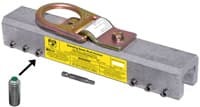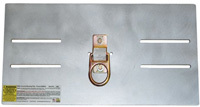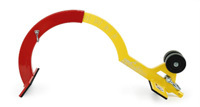Fall Protection Strategies for BEMO USA Standing Seam Roofs
Posted by Howie Scarboro - CEO Fall Protection Distributors, LLC on Nov 8th 2024
See the Roof Anchor Compatibility Chart for BEMO USA Standing Seam Panels.

Who Is BEMO USA?
BEMO USA is a top-tier manufacturer of high-performance metal roofing and wall panel systems. It is recognized worldwide for its architectural ingenuity and advanced panel customization. Originally founded as a branch of Kovach Panel Wall Systems, BEMO became its own entity in 2001 under the leadership of Richard Kovach. The company, headquartered in Mesa, Arizona, has grown its influence far beyond the United States, with a global presence across North America, Europe, the Middle East, Central America, and South America. BEMO's commitment to quality and a focus on customer satisfaction has propelled its reputation as a reliable partner in the metal construction industry.
One of BEMO USA's standout capabilities is its on-site production using BEMO-Mobile Factory Mills™, enabling efficient, end-to-end manufacturing directly at project sites. This unique mobile approach prevents potential damage during transportation, maintains panel integrity, and allows for the production of full-length panels without end laps. BEMO's mobile mills are renowned for their high-speed output. They can stretch and shape up to 150 feet of metal per minute, keeping projects on schedule and controlling labor costs. The company's expertise doesn't stop at production speed; BEMO also delivers versatility with customizable standing seam panel shapes, including tapered, curved, serpentine, convex, and concave forms. Using durable metals like zinc, stainless steel, aluminum, and Galvalume, BEMO USA creates standing seam panels that meet stringent structural demands while offering flexibility in architectural design.
With a focus on innovative design, energy efficiency, and sustainability, BEMO continues to provide premium roofing solutions to projects worldwide, ensuring each panel combines strength and style for long-lasting performance.
Why Are Compatible Fall Protection Anchors Critical For BEMO Roofing Panels?
Given BEMO's range of complex architectural designs—from gently curved panels to sharp, sleek seams—choosing the proper fall protection anchor is essential to preserving the roof's aesthetics and durability. Each BEMO panel system, especially those manufactured with proprietary materials or unique shapes, requires non-penetrating, compatible anchoring to prevent roof damage and ensure worker safety. Why is this so crucial? Attaching incompatible anchors could compromise the roof's structural integrity, affecting everything from watertight seals to thermal expansion properties.
For instance, BEMO's popular standing seam systems, which include models like the BEMO 305, 400, and 500, are designed with intricate seam profiles that provide weather resistance and structural strength. Non-compatible anchors that penetrate or clamp onto these unique seam shapes could cause water infiltration, affect wind uplift ratings, or lead to material degradation. That's why specialized, non-penetrating clamps like the SSRA1 Seam Anchor or systems such as the Ridge Pro Steep Assist are recommended for BEMO panels, as they safely grip the seam without puncturing or damaging it.
Additionally, BEMO's panels are often customized with BEMO-Flex™ multi-axis attachment points that control each clip's height, angle, and pitch, adding another layer of complexity for fall protection systems. With compatible fall protection anchors, workers can safely install and maintain these intricate roofing systems while maintaining the architectural and functional integrity of the BEMO panels. After all, what's the point of installing a stunning roof if improper anchoring undermines its longevity?
Curved BEMO Roofs and Fall Protection Considerations
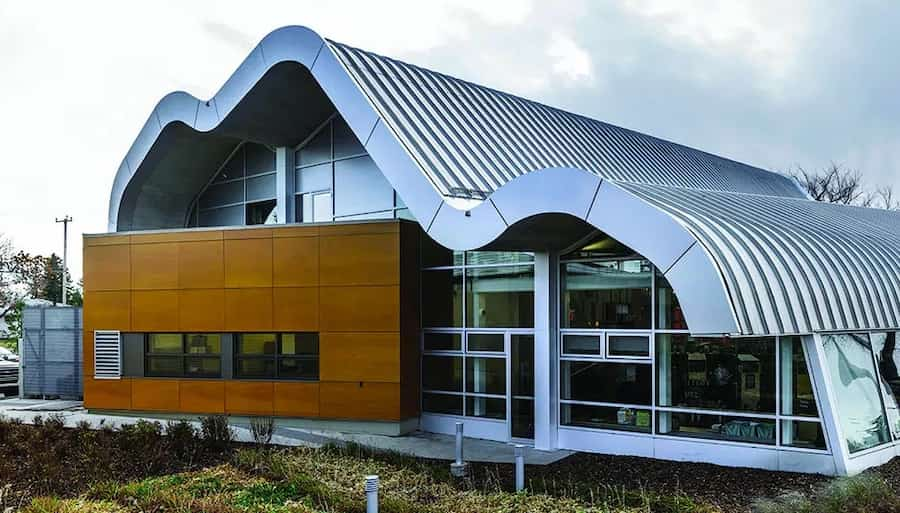
BEMO USA's commitment to architectural innovation extends to curved metal roofing options, enabling dynamic, flowing roof designs that add sophistication to any structure. Curved BEMO panels, whether they feature gentle arcs, sharp bends, or complex forms like serpentine or convex shapes, provide architectural flexibility while meeting rigorous structural standards. However, these unique profiles present challenges regarding ensuring worker safety through fall protection.
For curved BEMO roofs, traditional fall protection anchors like the SSRA and Ridge Pro systems are not compatible. Curved panels have unique tension points and angles that make them incompatible with standard, non-penetrating clamps, which rely on straight, consistent seam profiles to safely secure without causing damage. Attempting to anchor SSRA or Ridge Pro products on a curved BEMO roof risks workers' safety and the integrity of the roof structure itself, potentially leading to deformation or leaks.
Given these complexities, a trained safety professional should inspect any curved BEMO roof before selecting and installing fall protection measures. These experts can design custom fall protection solutions tailored to the roof's unique curvature, ensuring worker safety and preserving BEMO's high-performance architectural aesthetics.
BEMO 305 Standing Seam Panel
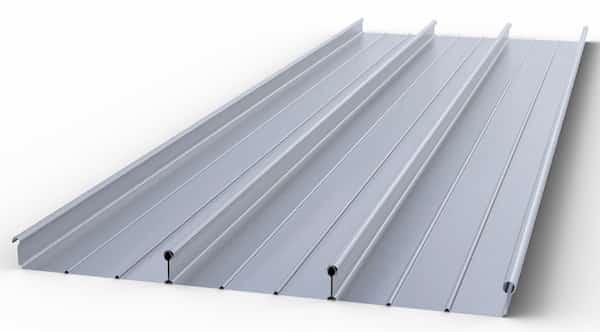
The BEMO 305 panel, with its narrower 12-inch width and 2-9/16 inch seam height, offers a versatile option for projects emphasizing aesthetics and structural resilience. This panel features a secure mechanical seam that withstands varied weather conditions. It enhances water tightness and wind uplift resistance, making it a reliable choice for complex architectural projects. Manufactured in 22—or 24-gauge steel, aluminum, or copper, the BEMO 305 panel can be adapted to both commercial and residential applications. See the Roof Anchor Compatibility Chart for BEMO 305 Standing Seam Panels.
A standout feature of the BEMO 305 panel is its adaptability to creative designs, including curved configurations. However, fall protection solutions like the SSRA1, SSRA2, SSRA3, and Ridge Pro Steep Assist are designed only for straight panels. For curved installations, it's essential to consult a trained safety expert to determine the most suitable fall protection system.
Fall Protection for BEMO 305 Panel
When used in flat panel applications, the BEMO 305 panel is compatible with the SSRA1, SSRA2, and SSRA3 fall protection products for 22 and 24-gauge steel. The SSRA1 Seam Anchor provides a solid foundation for the entire system, clamping directly to the seam without puncturing the roof, preserving the panel's weatherproofing. This non-penetrating approach ensures the panel remains watertight while providing a durable anchor point for additional fall protection components.
For projects that require stable walkways, the SSRA2 Adjustable Roof Jack Adapter can be attached to the SSRA1, accommodating a 10-foot walk board across the roof. This walk board is a steady, level platform, particularly beneficial on the narrower 305 panel where stable footing is essential. The SSRA2's adjustability makes it adaptable to different seam heights, allowing workers to navigate sloped areas with increased safety.
The SSRA3 Anchor Plate, mounted on two SSRA1 Seam Anchors, securely attaches a 100-foot temporary horizontal lifeline. This lifeline provides continuous fall protection across wider roof sections, allowing workers to move freely without detaching and reattaching anchors. For aluminum or copper 305 panels and other steel gauges, the Ridge Pro Steep Assist offers a secure alternative on slopes between 6/12 and 12/12, anchoring over the roof's ridge without penetrating the panel surface.
BEMO 400 Standing Seam Panel
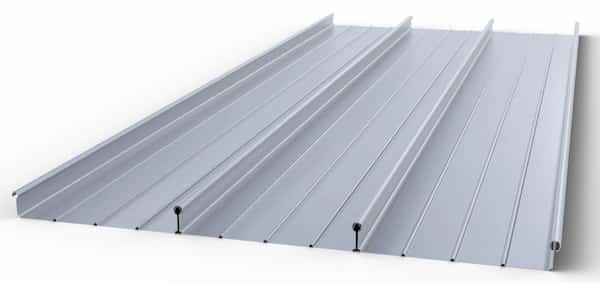
The BEMO 400 panel offers broader coverage with its 15-3/4 inch width and 2-9/16 inch seam height, designed to meet the needs of large commercial roofing applications. This wider profile contributes to installation efficiency, requiring fewer seams and providing a smooth, cohesive appearance. Constructing the BEMO 400 panel from 22- or 24-gauge steel, aluminum, or copper makes it an ideal choice for projects that require a durable and visually striking solution. See the Roof Anchor Compatibility Chart for BEMO 400 Standing Seam Panels.
You can install this panel in curved configurations to match unique architectural styles. However, curved versions require custom fall protection solutions, as the SSRA and Ridge Pro systems are only compatible with straight panels. Consulting with a safety professional for curved designs ensures appropriate, secure fall protection measures are in place.
Fall Protection for BEMO 400 Panel
For straight installations in 22— and 24-gauge steel, the BEMO 400 panel is fully compatible with the SSRA1, SSRA2, and SSRA3 products. The SSRA1 Seam Anchor attaches securely to the panel's seam without penetrating the roof, preserving watertight integrity and structural stability. This seamless connection enables the SSRA1 to support additional fall protection elements effectively.
The SSRA2 Adjustable Roof Jack Adapter, which mounts onto the SSRA1, provides a secure base for 10-foot walk boards. This setup is particularly beneficial on the wider BEMO 400 panels, offering workers a stable platform that spans the width of the roof. The SSRA2's adjustable height feature accommodates different seam heights, enhancing worker stability and reducing fall risks.
The SSRA3 Anchor Plate can be installed between two SSRA1 anchors, forming a secure attachment point for a 100-foot temporary horizontal lifeline to allow safe horizontal movement across large roof areas. This lifeline provides continuous protection for workers moving along the roof, minimizing the need for reattachment. For non-steel BEMO 400 panels or alternative gauges, the Ridge Pro Steep Assist is recommended for use on roof pitches between 6/12 and 12/12, offering a ridge-mounted, non-invasive anchor point.
BEMO 500 Standing Seam Panel
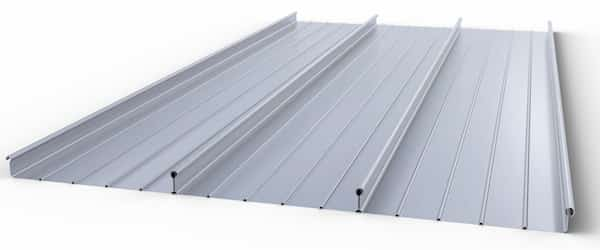
The BEMO 500 panel is the widest option in the BEMO lineup, offering 19-3/4 inches of coverage with a 2-9/16 inch seam height. Its broad profile is ideal for large roof surfaces where seamless installation and visual cohesion are essential. The BEMO 500 withstands demanding environmental conditions due to its durable materials, such as 22 or 24-gauge steel, aluminum, and copper, making it suitable for industrial, commercial, and architectural applications. See the Roof Anchor Compatibility Chart for BEMO 500 Standing Seam Panels.
We recommend using straight configurations of the BEMO 500 panel for compatibility with SSRA1, SSRA2, SSRA3, and Ridge Pro fall protection solutions. However, you can customize this panel for curved profiles. Safety professionals should guide the selection of specialized fall protection systems for curved installations to ensure worker safety and maintain roof integrity.
Fall Protection for BEMO 500 Panel
When installed straight in 22 or 24-gauge steel, the BEMO 500 panel is compatible with the complete SSRA fall protection system. The SSRA1 Seam Anchor provides a stable, non-penetrating anchor point by clamping onto the panel's seam, maintaining the roof's structural integrity. This robust connection ensures the SSRA1 is a secure base for additional fall protection components.
The SSRA2 Adjustable Roof Jack Adapter can be mounted on the SSRA1 to support 10-foot walk boards. This configuration creates a level and stable platform across the surface of the BEMO 500 panel, offering safe movement for workers. The SSRA2's adjustable height accommodates different seam profiles, enhancing safety across various project requirements.
You can combine the SSRA3 Anchor Plate with two SSRA1 anchors to create an attachment point for a 100-foot temporary horizontal lifeline, enabling extensive mobility across the roof. This setup allows workers to traverse large roof areas while staying tied off. For non-steel BEMO 500 panels or other gauges, the Ridge Pro Steep Assist provides a reliable alternative for roof pitches between 6/12 and 12/12, attaching securely to the ridge without penetrating the roof.
In summary, while the SSRA products are ideal for straight installations on 22-gauge and 24-gauge steel BEMO panels, curved configurations require customized fall protection. A trained safety expert should inspect curved panels to recommend the best strategies, ensuring roof preservation and worker safety.
Standing Seam Metal Roof Anchor Panel Compatibility Chart For BEMO USA
BEMO 305 Panel |
BEMO 400 Panel |
BEMO 500 Panel |
|
|---|---|---|---|
| YES | YES | YES | |
| YES | YES | YES | |
| YES | YES | YES | |
| YES | YES | YES | |
| YES | YES | YES |
Contact Us For More Information
For further details on roofing solutions and fall protection systems, contact us at 863-703-4522 or www.StandingSeamRoofAnchor.com. Let's work together to make your roofing projects safe, beautiful, and built to last. For more safety tips, check out OSHA's 48-page fall protection manual. Once you have determined the most suitable anchors for your roof system, download our free Anchor Inspection Form.
Safety Tips For Standing Seam Roofs
Install Permanent Roof Anchor Systems
If your building requires frequent maintenance, installing permanent roof anchors is wise. These fixed anchors provide a consistent, ready-made tie-off point, making every subsequent maintenance task quicker and safer. This setup is particularly beneficial for commercial properties, where ongoing access is essential. A permanent system boosts safety and reduces prep time for every visit to the rooftop—something any work crew can appreciate.
Ensure Proper Footwear for Stability
Proper footwear is non-negotiable when it comes to roofing. Metal roofs can be treacherously slippery when wet or icy, and wearing non-slip boots reduces that risk. I once saw a guy wearing sneakers—let's say it didn't end well. Good boots give better traction and stability, particularly on sloped surfaces, and they keep feet comfortable for those long workdays.
Use Specialized Anchor Systems for Standing Seam Roofs
Are they working on standing seam roofs? Ditch the screws and nails for clamp-on anchors that won't puncture the panels. The correct anchor prevents leaks and maintains the roof's integrity. Trust me, there's nothing worse than discovering your fall protection damaged the roof—imagine the repair bill! Using the correct, non-penetrating system saves everyone a headache down the line. Avoid using seam anchors that require mounting over the hidden panel clips, as these clips are nearly impossible to locate on existing roofs.
Promote a Culture of Safety
Safety gear is crucial, but it only goes so far without a safety culture backing it up. Regular toolbox talks, safety meetings, and open dialogue about hazards create a vigilant work environment. When workers feel safe speaking up, the whole crew operates more efficiently. It's like adding an extra layer of security. Everyone looks out for each other, and accidents are less likely.
Develop OSHA-Compliant Safety Plans
Before setting foot on a roof, have an OSHA-compliant safety plan. This plan should outline fall protection measures and emergency rescue steps. Think of it like a spare tire—you hope you don't need it, but it's there just in case. A solid safety plan prepares you to respond swiftly and effectively if anything goes wrong. One of the most overlooked components of a safety plan is the rescue plan. The crew must prepare to rescue any worker who experiences an accident. Having the right tools and training readily available can save lives!
Encourage the Use of Trauma Straps
Trauma straps are an absolute must. Imagine a worker suspended in a harness after falling. In that case, the straps help prevent suspension trauma by relieving leg pressure. Ensure everyone knows how to use them, too—it's no good if they're unfamiliar in an emergency. Trauma straps are a small investment but can make a huge difference in worker safety and survival.
Consult Experts for Curved Metal Panels
Curved metal roofs are a different beast entirely. Standard seam anchors don't always secure properly to curved panels, so it's essential to get expert advice for fall protection solutions. Consulting with a trained safety expert for a custom approach isn't just bright—it's necessary. Protecting your crew and preserving the roof's structure are top priorities, and this step ensures both.
Ensure Stable Access Points
Stable ladders and scaffolding aren't just helpful—they're essential for roof access. Position ladders on firm, level ground and follow the 4-to-1 rule: for every four feet of height, the ladder's base should be one foot out. This little trick goes a long way in preventing slips and ensuring safer access up and down.
Equip Workers with High-Quality Safety Gear
Investing in durable, comfortable safety gear means fewer "forgotten" harnesses and lanyards in the truck. A reliable full-body harness, shock-absorbing lanyard, and other fall arrest systems are like good brakes—there when you need them. Prioritizing comfort encourages compliance, which ultimately saves lives on the job.
Set Up Protective Barriers for Work Zones
Guardrails and warning lines are essential for defining safe work zones on large or low-slope roofs. Think of these as bumpers for the roof—added protection against the edge. With clear boundaries, workers can focus on their tasks without the risk of accidentally venturing too close to unsafe areas, keeping everyone on track and reducing fall risks.
By following these safety tips, you'll ensure the well-being of your crew, improve overall productivity, and protect the roof system—a win-win for everyone involved!
Disclaimer
The views, recommendations, and information presented in this blog are solely those of the author and do not necessarily reflect the opinions or positions of the featured panel manufacturer, its brands, subsidiaries, or parent companies. Customers are strongly encouraged to reach out directly to the roof panel manufacturer for inquiries regarding fall protection compatibility with their products and to address any potential warranty issues that may arise following the installation of our products.



